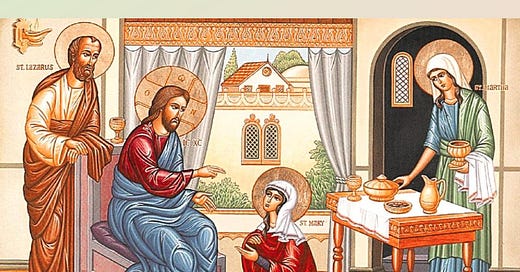Isaiah 42:1-7; Ps 27:1, 2, 3, 13-14; John 12:1-11
Psalm 27 with its proclamation that “The LORD is my light and my salvation” (Ps 27:2) accompanies the celebration of the victory of life over death in Bethany, in the house of Lazarus, Martha, and Mary. Instead of a funeral meal for the deceased Lazarus, we have a joyful dinner. Martha served, Lazarus reclined at the table with Jesus, and Mary anointed Jesus’ feet with a costly perfumed oil (see John 12:2-3)
The psalmist declares his faith in God’s intervention on his behalf by stating “I believe that I shall see the bounty of the LORD in the land of the living” (Ps 27:13). Then, he adds that we should wait for God’s intervention to ‘transfer’ us from the realm of death to the land of the living. We can see the confirmation of the psalmist’s faith in the resurrection of Lazarus. He was ‘waiting’ four days in the tomb to hear the voice of Jesus the Lord who is the resurrection and the life. And, when the voice of the Lord cried out, “Lazarus, come out” (John 11:43), the dead man came out of the tomb.
In the first reading, we hear a part of the first of the four songs of Isaiah describing God’s servant (Is 42:1-9). The servant is “a light for the nations” and his mission is “to open the eyes that are blind, to bring out the prisoners from the dungeon, from the prison those who sit in darkness” (Is 42:6,7). It is not difficult to realise that Jesus perfectly fulfils the role of this servant. All the Gospels narrate the stories where Jesus opened the eyes of the blind so they could see (see Mark 10:46-52; John 9:1-41). Those stories point to another kind of blindness that develops in our hearts. Like Christ’s disciples and the Pharisees, we have difficulties in understanding who Jesus is, what His mission is, and what it means to follow Him.
The Gospels also include stories of people who were imprisoned either by forces of evil or the power of death. There is the story of a man possessed by a legion of demons that wanted to destroy him (see Mark 5:1-20). There are three accounts of Jesus bringing the dead back to life: the twelve-year-old girl, the only son of a widow, and Lazarus (Mark 5:35-43; Luke 7:11-17; John 11:1-44). These stories look forward to Jesus’ final victory over sin, evil, and death through his death on the cross. The cross becomes the tree of life. Now everyone who believes in the crucified Lord of Glory is set free from the power of sin, evil, and death.
The silent witness of Lazarus is a surprising feature of today’s Gospel. Looking at him sitting there with Jesus by the table and knowing what Jesus did for him led many to faith. Lazarus proclaimed the Gospel simply by being alive. One of the early Fathers of the Church, Saint Irenaeus wrote that “the glory of God is a human person being fully alive”. Our world needs to see us, the followers of Jesus, fully alive in Christ.




